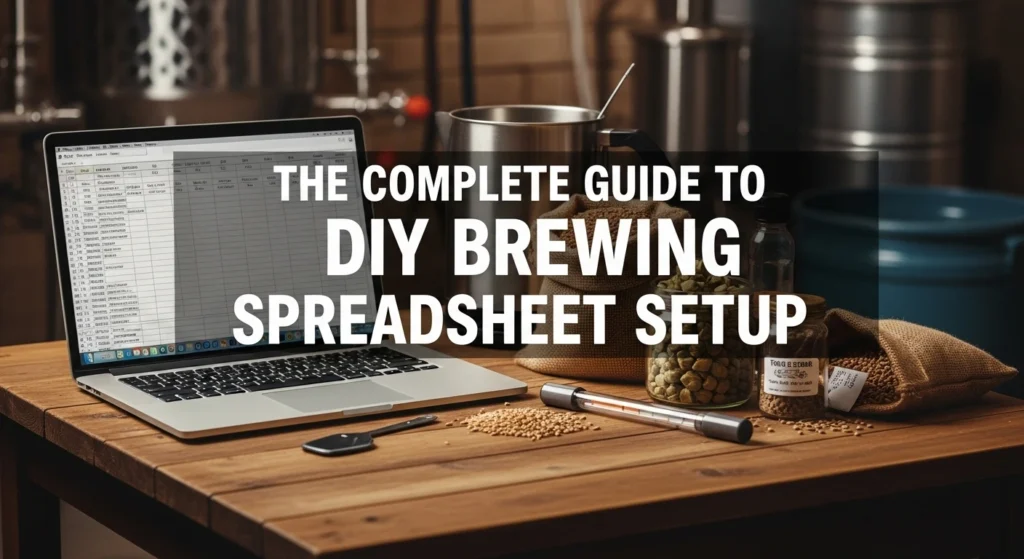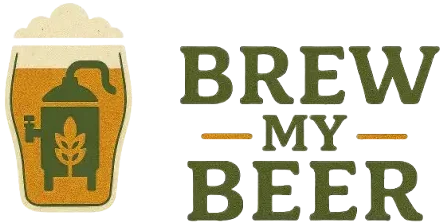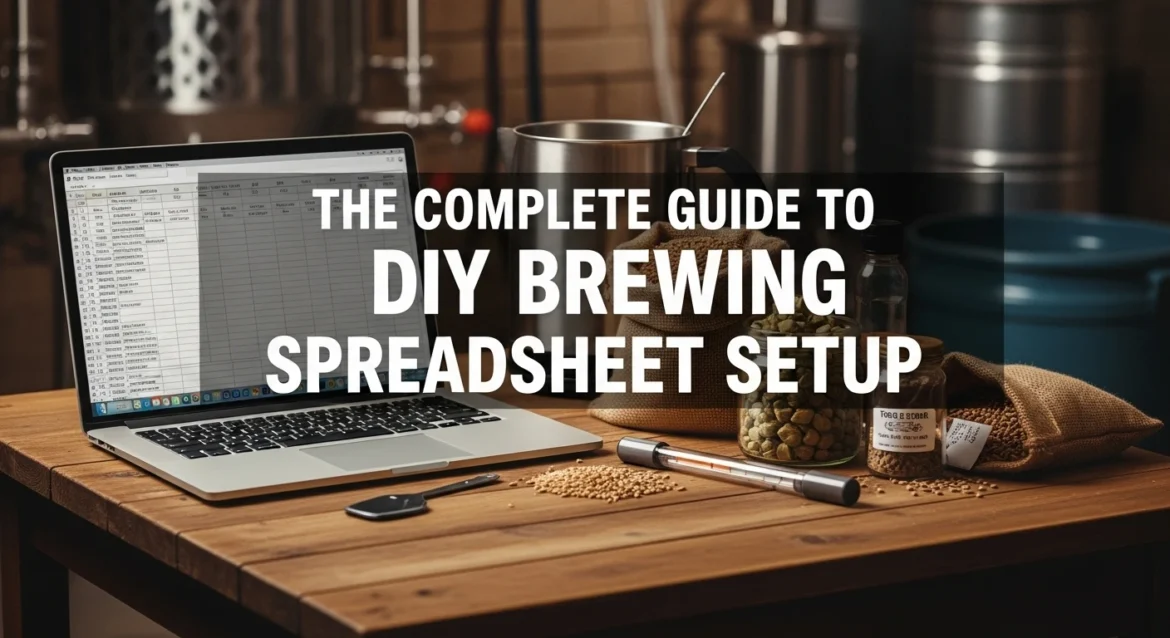The Complete Guide to DIY Brewing Spreadsheet Setup Create powerful, customized brewing calculators with this comprehensive guide to DIY brewing spreadsheet setup. Learn to build professional-grade recipe calculators, water chemistry tools, and batch tracking systems using Excel or Google Sheets.

A well-designed DIY brewing spreadsheet setup transforms complex brewing calculations into an organized, automated system that professional brewers rely on daily. Creating your own customized brewing calculator eliminates subscription fees while providing complete control over features, formulas, and data organization.
Modern homebrewers increasingly turn to DIY brewing spreadsheet setup solutions after discovering the limitations of commercial software. These custom-built tools offer unlimited flexibility, allowing brewers to incorporate specific equipment parameters, unique calculation methods, and personalized brewing workflows.
Whether you’re an extract brewer seeking basic calculations or an all-grain enthusiast requiring comprehensive water chemistry analysis, a properly configured DIY brewing spreadsheet setup delivers professional-grade functionality at zero ongoing cost. This guide provides step-by-step instructions for building sophisticated brewing calculators that rival expensive commercial alternatives.
Understanding Spreadsheet-Based Brewing Calculations
Spreadsheet applications like Microsoft Excel and Google Sheets provide powerful platforms for DIY brewing spreadsheet setup projects. These tools offer advanced mathematical functions, database capabilities, and automation features that handle complex brewing calculations with professional accuracy.
The foundation of effective DIY brewing spreadsheet setup lies in understanding how brewing formulas translate into spreadsheet functions. Alcohol by volume calculations, International Bitterness Unit formulas, and gravity corrections all convert readily into automated spreadsheet calculations.
The Complete Guide to DIY Brewing Spreadsheet Setup Core Mathematical Functions
Basic brewing calculations form the building blocks of any DIY brewing spreadsheet setup. The ABV formula (OG – FG) × 131.25 provides alcohol content estimates, while the Tinseth equation calculates hop bitterness contributions.reddit+1
Gravity correction formulas account for temperature variations in hydrometer readings. The standard correction formula: CG = MG × ((1.00130346 – 0.000134722124 × TR + 0.00000204052596 × TR² – 0.00000000232820948 × TR³) / (1.00130346 – 0.000134722124 × CR + 0.00000204052596 × CR² – 0.00000000232820948 × CR³)) enables accurate gravity measurements.
Color calculations using the SRM formula predict beer appearance: SRM = 1.4922 × ((pounds of grain × degrees Lovibond) / gallons)^0.6859. These mathematical foundations enable sophisticated DIY brewing spreadsheet setup implementations.
| Spreadsheet Name | Cost | Complexity Level | Recipe Builder | Water Chemistry | Equipment Profiles | Batch Tracking | Mobile Friendly | Best For |
|---|---|---|---|---|---|---|---|---|
| Larry’s Brewing Template v5 | Free (Donations) | Advanced | Full Featured | EZ Water Integration | Multiple Systems | Advanced | Limited | All Brewing Methods |
| Homebrew Spreadsheet | Free | Intermediate | Basic | Basic | Single Profile | Basic | No | Extract Brewers |
| EZ Recipe Design | $15 one-time | Advanced | Advanced | Limited | Advanced | Good | No | Commercial Scale |
| BIAB Spreadsheet | Free | Beginner | Limited | Basic Calcs | BIAB Focused | Limited | Limited | BIAB Only |
| Custom DIY Setup | Free | Customizable | Build Your Own | Manual Setup | Custom | DIY | Depends | Custom Needs |
Essential Components for Your Brewing Spreadsheet
Effective DIY brewing spreadsheet setup requires multiple interconnected components working together seamlessly. The core elements include recipe builders, equipment profiles, calculation engines, and data tracking systems.youtubescribd
Starting with basic components allows gradual expansion as brewing knowledge and spreadsheet skills develop. Beginning brewers benefit from simple ABV and IBU calculators before advancing to complex water chemistry and mash temperature calculations.
Recipe Builder Foundation
The recipe builder serves as the central hub for DIY brewing spreadsheet setup projects. This component integrates ingredient databases, calculation formulas, and equipment parameters to predict finished beer characteristics.
Grain bill calculations require extract potential values for different malt types. Pale malt typically yields 1.037 specific gravity per pound per gallon, while specialty malts contribute color and flavor with varying extract potentials.
Hop schedule calculations integrate alpha acid percentages, boil times, and utilization rates. The Tinseth utilization formula: Utilization = f(G) × f(T) where f(G) = 1.65 × 0.000125^(Gravity – 1) and f(T) = (1 – e^(-0.04 × Time)) / 4.15 provides accurate bitterness predictions.
Equipment Profile Configuration
Equipment profiles customize calculations for specific brewing systems in DIY brewing spreadsheet setup. Mash tun volumes, kettle capacities, and system losses directly impact recipe formulations and water calculations.
Dead space measurements account for liquid remaining in equipment after transfers. Typical homebrewing systems lose 0.5-1.0 gallons to trub, hops, and equipment dead space.
Efficiency ratings personalize extract calculations for individual brewing systems. All-grain brewers typically achieve 70-85% brewhouse efficiency, requiring ongoing calibration as techniques improve.
Setting Up Your Base Spreadsheet Structure
Organizing your DIY brewing spreadsheet setup with logical tab structure improves usability and maintenance. Separate worksheets for recipes, calculations, databases, and tracking prevent formula conflicts while enabling modular development.scribdyoutube
The main recipe sheet should display essential brewing information in printable format. Supporting calculation sheets perform background mathematics while ingredient databases store malt, hop, and yeast specifications.
Worksheet Organization Strategy
Effective DIY brewing spreadsheet setup employs consistent naming conventions and color coding. Input cells use light colors while calculated values display in contrasting colors to prevent data entry errors.
Header rows and column labels improve navigation in complex DIY brewing spreadsheet setup projects. Freeze panes functionality maintains visible headers during scrolling through extensive ingredient lists.
Data validation prevents input errors by restricting cell entries to acceptable ranges. Drop-down lists for ingredient selection ensure consistent spelling and database integrity.youtubehomebrewfinds
| Component | Difficulty to Build | Essential for Beginners | Excel Formula Complexity | Updates Required |
|---|---|---|---|---|
| Recipe Builder | Intermediate | Yes | Medium | Frequent |
| Equipment Profile | Beginner | Yes | Low | Rare |
| Water Calculator | Advanced | Optional | High | Occasional |
| IBU Calculator | Intermediate | Yes | Medium | Rare |
| ABV Calculator | Beginner | Yes | Low | Never |
| Color Calculator | Intermediate | Yes | Medium | Rare |
| Mash Calculator | Advanced | No | High | Rare |
| Yeast Starter Calculator | Advanced | No | High | Rare |
| Carbonation Calculator | Intermediate | Yes | Medium | Rare |
| Cost Calculator | Beginner | Optional | Low | Frequent |
| Batch Tracker | Intermediate | Optional | Medium | Every Batch |
| Inventory Manager | Advanced | No | High | Frequent |
Data Input and Validation
Input validation ensures data integrity in DIY brewing spreadsheet setup implementations. Numeric ranges prevent impossible values like negative hop additions or gravity readings below 1.000.
Conditional formatting highlights potential issues in DIY brewing spreadsheet setup calculations. Red cells can indicate out-of-range values while green cells confirm acceptable parameters.
Error checking formulas identify calculation problems before brewing begins. IF statements can display warning messages when recipes exceed equipment capacities or fall outside style guidelines.
Building Essential Calculation Modules
Core calculation modules form the mathematical foundation of DIY brewing spreadsheet setup projects. These automated functions eliminate manual calculations while ensuring accuracy across multiple recipe iterations.
Starting with simple calculators builds confidence before tackling complex formulas. ABV and gravity calculations provide immediate value while establishing spreadsheet development skills.
ABV and Gravity Calculators
Alcohol by volume calculations represent the most fundamental component of DIY brewing spreadsheet setup. The standard formula converts gravity readings into alcohol percentages using the relationship between sugar consumption and alcohol production.
Advanced ABV calculations account for temperature corrections and alternate formula options. The alternate ABV formula: ABV = (OG – FG) × 131.25 provides slightly different results for high-gravity beers.
Gravity prediction formulas estimate original gravity based on grain bills and batch sizes. The basic calculation: OG = 1 + ((pounds × points) / gallons) / 1000 where points represent extract potential enables recipe formulation.
IBU and Hop Calculations
Bitterness calculations require sophisticated formulas in DIY brewing spreadsheet setup projects. The Tinseth utilization model accounts for boil time, wort gravity, and alpha acid content to predict International Bitterness Units.
Hop utilization varies significantly with boil timing and wort characteristics. Sixty-minute additions achieve maximum utilization while late additions contribute more aroma than bitterness.
Gravity adjustment factors modify hop utilization based on wort density. Higher gravity worts extract fewer bittering compounds, requiring increased hop additions to achieve target IBU level
Advanced Water Chemistry Integration
Water chemistry calculations represent the most complex aspect of DIY brewing spreadsheet setup. These sophisticated tools predict mash pH, recommend mineral additions, and optimize water profiles for specific beer styles.
Integration with established water calculators simplifies development while ensuring accuracy. The EZ Water Calculator provides proven formulas that integrate seamlessly with custom spreadsheet designs.
pH Prediction Algorithms
Mash pH prediction requires complex calculations accounting for grain composition and water alkalinity. The basic pH formula considers buffering capacity of malts and alkalinity of brewing water.
Grain acidity values enable pH calculations for different malt combinations. Base malts contribute minimal acidity while darker malts provide significant pH reduction.
Alkalinity neutralization calculations determine acid additions needed for pH adjustment. Lactic acid and phosphoric acid provide different neutralization capacities requiring specific calculation formulas.
Mineral Addition Calculators
Salt addition calculations optimize brewing water for specific beer styles in DIY brewing spreadsheet setup. Gypsum enhances hop character while calcium chloride accentuates malt sweetness.
Ion balance calculations prevent over-mineralization of brewing water. Excessive mineral additions can create harsh, metallic flavors or interfere with yeast performance.
Water profile databases store target profiles for famous brewing regions. Burton-on-Trent water enhances hoppy beers while Pilsen water creates soft, delicate lagers.
Recipe Scaling and Batch Management
Recipe scaling capabilities enable batch size adjustments while maintaining proper ingredient ratios. Linear scaling works for most ingredients, though hop utilization may require adjustment for significantly different volumes.
Batch tracking features document brewing history and performance trends. These records identify process improvements and enable recipe refinement over time.
Scaling Algorithms and Accuracy
Scaling formulas maintain recipe balance across different batch sizes in DIY brewing spreadsheet setup. Most ingredients scale linearly, but hop utilization and yeast pitch rates may require non-linear adjustments.
Equipment efficiency differences affect scaling accuracy. Larger systems often achieve higher efficiency, requiring grain bill adjustments for equivalent beer strength.
Process variations can impact scaled recipes. Boil-off rates, trub losses, and fermentation characteristics may differ between batch sizes.
Batch Documentation and Analysis
Comprehensive batch tracking enables process optimization in DIY brewing spreadsheet setup projects. Recording actual versus predicted values identifies calculation accuracy and system performance.
Statistical analysis reveals brewing trends and improvement opportunities. Efficiency tracking, attenuation rates, and timing consistency provide actionable insights.
Cost analysis features track ingredient expenses and batch economics. These calculations support inventory management and brewing budget planning.
Integration with External Tools and Data
Modern DIY brewing spreadsheet setup benefits from integration with external brewing tools and databases. Water calculator spreadsheets, ingredient databases, and equipment specifications enhance calculation accuracy.
Cloud storage enables access across multiple devices while maintaining data synchronization. Google Sheets provides collaborative features for sharing recipes and brewing data.
Database Connectivity Options
Ingredient databases enhance DIY brewing spreadsheet setup with comprehensive malt, hop, and yeast specifications. These external sources provide extract potentials, alpha acid contents, and flavor characteristics.
API connections enable real-time data updates from supplier websites. Current pricing and availability information supports inventory management and cost calculations.
Equipment manufacturer specifications integrate seamlessly with DIY brewing spreadsheet setup calculations. Kettle volumes, heating rates, and efficiency ratings improve calculation accuracy.
Cloud Synchronization and Backup
Cloud storage protects valuable brewing data while enabling multi-device access. Regular backups prevent data loss from hardware failures or software corruption.reddityoutube
Version control systems track recipe modifications and formula updates. Historical versions enable rollback to previous configurations when problems occur.
Sharing capabilities facilitate collaboration with other brewers and recipe development. Export functions enable data portability between different software platforms.
Troubleshooting Common Setup Issues
DIY brewing spreadsheet setup projects often encounter formula errors, calculation discrepancies, and performance issues. Systematic troubleshooting approaches identify root causes and implement effective solutions.
Common problems include circular references, missing cell links, and incorrect formula syntax. Understanding Excel error messages and debugging techniques prevents frustration during development.
Formula Debugging Techniques
Trace precedents and dependents functions identify formula relationships in complex DIY brewing spreadsheet setup. These tools reveal calculation flows and locate broken cell links.
Error checking functions identify potential calculation problems. Formula auditing reveals inconsistent formulas and missing references that affect accuracy.
Step-through calculation enables manual verification of complex formulas. Breaking complicated calculations into intermediate steps simplifies debugging and validation.
Performance Optimization
Large DIY brewing spreadsheet setup projects may experience slow performance with extensive calculations. Optimization techniques include reducing volatile functions and minimizing array formulas.
Conditional calculations prevent unnecessary processing in unused portions of spreadsheets. IF statements can disable calculation-intensive features when not needed.
Data organization affects performance significantly in complex DIY brewing spreadsheet setup. Proper indexing and lookup table structure improve calculation speed.
Customization for Different Brewing Methods
Different brewing methods require specialized calculations in DIY brewing spreadsheet setup projects. Extract brewing focuses on simple gravity and bitterness calculations while all-grain requires complex mash and sparge calculations.
BIAB (Brew in a Bag) brewing needs specific water volume calculations accounting for grain absorption. Partial mash brewing combines extract and all-grain calculations in hybrid approaches.
Extract Brewing Adaptations
Extract brewing simplifies DIY brewing spreadsheet setup by eliminating mash calculations. Focus shifts to gravity contributions from liquid and dry malt extracts.
Steeping calculations determine specialty grain contributions in extract recipes. Color and flavor extractions require different formulas than all-grain equivalents.
Late extract addition techniques prevent color darkening in light beers. Timing calculations optimize extract additions for color and flavor goals.
All-Grain Brewing Complexity
All-grain brewing requires sophisticated mash calculations in DIY brewing spreadsheet setup. Strike water temperature, mash thickness, and sparge water calculations demand advanced formulas.
Efficiency tracking becomes critical for all-grain recipe formulation. Brewhouse efficiency calculations account for mash, lauter, and boil losses.
Multi-step mash calculations support complex temperature programs. Decoction and step-mash schedules require precise volume and temperature calculations.
Advanced Features and Automation
Advanced DIY brewing spreadsheet setup implementations incorporate automation features that reduce manual input and prevent errors. Macro programming, conditional formatting, and automated reports enhance usability.
Integration with brewing equipment enables real-time data collection and analysis. Temperature sensors, digital scales, and pH meters can feed data directly into spreadsheet calculations.
Macro Programming and Automation
Visual Basic for Applications (VBA) programming extends DIY brewing spreadsheet setup capabilities. Automated functions can generate shopping lists, format reports, and perform complex calculations.
User forms simplify data entry while maintaining calculation integrity. Custom interfaces guide users through recipe development while preventing input errors.
Automated backup systems protect valuable brewing data. Scheduled saves and cloud synchronization ensure data security and accessibility.
Equipment Integration Possibilities
Digital scale integration automates ingredient measurements in advanced DIY brewing spreadsheet setup. Bluetooth-enabled scales can transmit weights directly to spreadsheet cells.
Temperature monitoring systems provide real-time mash and fermentation data. Continuous logging enables precise process control and documentation.
pH meter connectivity automates water chemistry calculations. Real-time pH readings enable immediate adjustment recommendations.
Best Practices and Optimization Tips
Successful DIY brewing spreadsheet setup requires systematic approach and attention to detail. Documentation, testing, and iterative improvement ensure long-term reliability and functionality.
Version control prevents data loss during modifications while enabling rollback to previous configurations. Regular testing with known values validates calculation accuracy.
Development Methodology
Modular development approach simplifies complex DIY brewing spreadsheet setup projects. Building individual components separately enables focused testing and debugging.
Progressive enhancement adds features gradually while maintaining core functionality. Starting with basic calculations and expanding capabilities prevents overwhelming complexity.
User feedback guides feature development and interface improvements. Testing with actual brewing scenarios reveals usability issues and calculation gaps.
Maintenance and Updates
Regular maintenance ensures continued accuracy in DIY brewing spreadsheet setup. Ingredient database updates, formula corrections, and feature enhancements require ongoing attention.
Backup strategies protect valuable brewing data and development work. Multiple backup copies and cloud storage prevent data loss from hardware failures.
Documentation facilitates future modifications and user training. Clear instructions and formula explanations enable other brewers to understand and modify spreadsheets.
Creating a comprehensive DIY brewing spreadsheet setup transforms homebrewing from guesswork into precise science while maintaining complete control over calculations and features. These custom-built tools provide professional-grade functionality without subscription costs or software limitations.
Success requires patience, systematic development, and thorough testing of all calculation components. Whether building simple extract brewing calculators or comprehensive all-grain systems with water chemistry integration, the flexibility of spreadsheet-based solutions enables unlimited customization for any brewing style or experience level.
As brewing knowledge and spreadsheet skills develop, these systems can grow and evolve to meet changing needs. The investment in learning spreadsheet development pays dividends through years of reliable brewing calculations and complete data ownership.
About Auther
Ryan Brewtech is a computer engineer developing IoT brewing solutions with over 12 years of experience in brewing software development and spreadsheet automation. He has created dozens of custom brewing calculators for breweries and homebrew shops, specializing in Excel VBA programming and database integration. Ryan holds a Master’s degree in Computer Engineering and brewing certifications from the Institute of Brewing and Distilling. His expertise spans from basic spreadsheet formulas to complex brewing automation systems, making him a trusted authority on DIY brewing calculation development and brewery data management.

